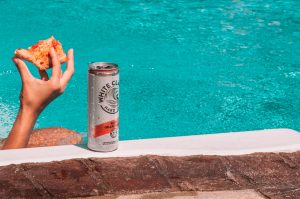Brands Crack Open a New RTD Experience
Published on October 9, 2020, at 8:45 a.m.
by Grace Evans.
Think back to a time when White Claws didn’t exist. When the only ready-to-drink, or RTD, coffee option was a bottled Starbucks Frappuccino. When a craving for a canned cocktail could only be met with a Four Loko. Consumers’ needs have changed, and if you weren’t paying attention, you may not have noticed one of the biggest shifts in the RTD market.

Convenient. Affordable. Premium. Better-for-you. Together, these consumer preferences have made way for an overwhelming variety of canned drinks that meet this new kind of demand. While RTD cans aren’t new, they weren’t a popular choice until the late 2000s. Some brands have only just entered the market, while others are building off of their existing product lines to leverage their brand equity and to capitalize on a loyal consumer base.
An analysis written by the International Wine and Spirits Record (IWSR) explained how the RTD market had to elevate its products to match consumers’ preferences for high-quality, complex and healthy choices. This complete rebrand of the market changed a landscape saturated with unimaginative, cloyingly sweet and juvenile selections that never quite found its target publics.
The canned drink that is splashed across social media at the moment is hard seltzers. Since Bon & Viv first released its spiked seltzer in 2013, brands like Truly, White Claw and most recently Bud Light have tried their hand at profiting from an over $1 billion industry. With each new product launch, consumers are more willing than ever to impulsively grab a six-pack and discover a new brand. Brands currently have the unique ability to position themselves as leaders of this modernized market segment, since only 10% to 15% of consumers stay loyal to a seltzer.
One of the ways these seltzers appeal to consumers is their low-calorie contents. By lowering the ABV and decreasing sugar content, a typical consumer isn’t afraid of drinking four to five cans in one night, since each can is usually around 100 calories.
However, despite the promise of a healthier choice, today’s consumers aren’t willing to sacrifice quality. 10 years ago if someone handed me canned wine, not only would I have been underage, but I also would have found a glass of Chardonnay in an aluminum can less than appealing.
Now, even wine has found a new way to reach younger consumers who are unabashed in their drink preferences. Just Enough Wine founder Jessica Hershfield launched a crowdfunding campaign on Indiegogo in July and after meeting her goal, cans will be available this month.

“We created a wine where no bottle openers are needed, wine glasses are optional, and you are free to enjoy wine as it should be, without pretense,” said Hershfield. Each can contains a glass and a half of wine, and consumers won’t have to compromise on the quality, as the company states that it works with some of the best winemakers in the world. The entrée of canned wine and even canned cocktails into the market proves that consumers want the convenience of premium drinks without the hassle or price tag that accompanies a night out, and brands are taking note.
Canned drinks’ success can easily be attributed to their functionality, but many brands have found that the aesthetic of the can and its branding captivate consumers and appeal to their penchant for novelty that keeps consumers coming back for more. Most cans on display in stores are sleek and eye-catching, like Heywell sparkling waters or CBD infused drink brand Recess, brands which also utilize social media platforms to intensify their branding. Even Starbucks has finally embraced consumer demands with the release of its RTD nitro cold brew, and it just so happens to come in a can.
Now, more than ever, consumers expect innovation and excitement from their RTD canned beverages. And while so many brands battle over market shares, their fates are ultimately in the hands of their publics. Whoever can continue to adapt to the ever-changing lifestyles of consumers while still providing quality, value and personalization will reign supreme.




